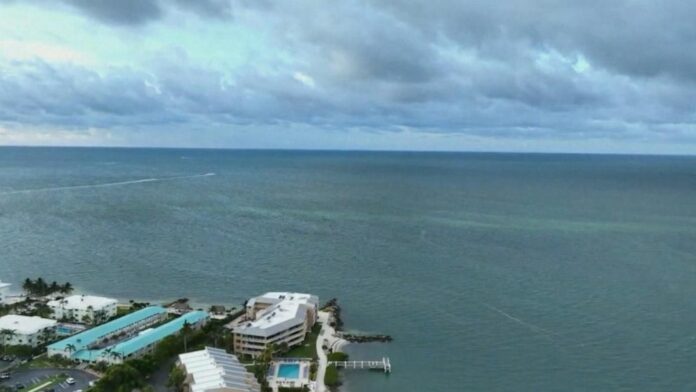
Excessively hot waters off the coast of South Florida rose to an unfathomable level Monday evening.
A buoy in Manatee Bay, about 40 miles south of Miami, posted a temperature of 101.1 degrees at 6 p.m. after a morning low of 91 degrees. Temperatures remained at or above 100 from 5 p.m. through late evening.
For comparison, the “ideal” temperature of a hot tub is 100 to 102 degrees, according to jacuzzi.com.
The Manatee Bay reading could be unprecedented globally, although there are no official records maintained for ocean temperatures. A study published in 2020 proposed that the highest sea surface temperature reliably observed may have been 99.7 degrees in the middle of Kuwait Bay, wrote Jeff Masters, a meteorologist and writer for Yale Climate Connections, in a thread on Twitter.
The temperature at Manatee Bay was measured at shallow levels about five feet below the surface – where waters can easily heat up. Masters tweeted that it’s not clear if the temperature is valid because of “contamination of the measurement by land effects and organic matter in the water.”
However, the Manatee Bay buoy temperature reading was among several extreme values in South Florida’s offshore waters.
To the southwest, a buoy near Johnson Key topped out at 98.4 degrees. The temperature hovered at or above 98 degrees for several hours during the evening.
A majority of buoys in the area reached or surpassed 95 degrees during the day. In fact, the average of the two dozen observation locations in and around Florida Bay was right around 96 degrees during the early evening.
The water temperatures were remarkable for being even higher than air temperatures. Masters explained on Twitter that “sunlit shallow water surrounded by dark land can have [a sea surface temperature] that exceeds the air temperature.”
The extreme ocean heat comes amid Florida’s hottest July on record. Miami, Key West, Naples, Tampa and many other cities are seeing their toastiest July. Most of South Florida is also experiencing its hottest year on record thus far, according to data compiled by the Southeast Regional Climate Center.
Miami has reached at least 90 degrees on 64 days, while Fort Myers and Key West have done so on 97 and 46 days, respectively, all of which are year-to-date records.
The heat index in Miami, taking into account humidity as well as air temperature, has reached at least 100 degrees on a record 44 straight days.
Meanwhile, overnight low temperatures have averaged 80 to 83 degrees over the past several weeks in these areas – allowing ocean temperatures to remain extremely warm.
Scorching waters off South Florida are only one of several regions in the Northern Hemisphere experiencing a marine heat wave, according to the National Oceanic and Atmospheric Administration’s Coral Reef Watch, which monitors ocean temperatures around the planet.
Other ocean hot spots include the Mediterranean Sea, which reached its hottest level on record Monday, averaging 83.1 degrees; the waters west of Peru; and the North Atlantic Ocean, where water temperatures are off the charts.
The abnormally warm waters surrounding South Florida and the Florida Keys are already damaging coral reefs, according to scientists.
The Coral Restoration Foundation, a nonprofit organization based in Key Largo that works to preserve and restore corals, wrote that the historically high water temperatures are creating “a severe and urgent crisis,” in a news release late last week.
On Thursday, scientists at the foundation visited Sombrero Reef, which is south of Marathon in the Florida Keys, to assess its health.
“What we found was unimaginable – 100% coral mortality,” said Phanor Montoya-Maya, the restoration program manager at the foundation, in the release. “We have also lost almost all the corals in the Looe Key Nursery in the Lower Keys.”
The foundation said the situation “underscores the urgency of addressing climate change.”
(c) 2023, The Washington Post · Ian Livingston, Jason Samenow












Travel is in high gear. All the attractions that anyone would love to see.
They are polluting with encouragement!
For the water temperature to be 101°, the outside temperature would have to have been way way way way way way way way way higher over a very very very far distance. This makes no sense whatsoever. It doesn’t take a rocket scientist to say that this makes no sense whatsoever.
The only way this might make sense is if they put the temperature probe right over an underground hot spring.
So what’s the message from shomayim?
Great! By the time I get down there in December, the waters should still be relatively warm
If they use manmade weather modification it’s a miracle they don’t make it 200 degrees.